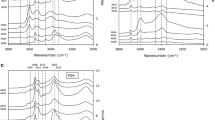Abstract.
The solubility of water in pure enstatite was measured on samples synthesized at 1,100 °C and pressures to 100 kbar. Enstatite crystals were grown under water-saturated conditions from a stoichiometric mixture of high-purity SiO2 and Mg(OH)2. Water contents were calculated from polarized FTIR spectra measured on oriented single crystals. The water solubility in orthoenstatite increases with pressure to 867±35 ppm H2O by weight at 75 kbar. At 100 kbar, in the stability field of high-clinoenstatite, a water solubility of 714±35 ppm was observed. The water solubility in enstatite at 1,100 °C can be described by the equation cH2O=AfH2O exp(–PΔV/RT), where f H2O is water fugacity, A=0.0204 ppm/bar and ΔV=12.3 cm3/mol. The infrared spectra of the hydrous enstatite crystals show a sharp, intense band at 3,363 cm–1 and a broad, weaker band at 3,064 cm–1. Both bands are strongly polarized parallel c. Most likely, pairs of protons attached to non-bridging oxygen atoms substitute for Mg2+. In order to investigate the effect of chemical impurities on water solubility in enstatite, an additional series of experiments was carried out with gels doped with Al, B, or Li as starting material. Whereas, the presence of Li and B had no detectable effect on water solubility, the addition of about 1 wt% Al2O3 increased water solubility in enstatite from 199 to 1,100 ppm at 1,100°C and 15 kbar. In the infrared spectra of these aluminous samples, additional bands occur in the range from 3,450 to 3,650 cm–1. Similar bands are also observed in natural, aluminous orthopyroxenes and are most likely caused by protons coupled with Al according to the substitution of Al3++H+ for Si4+. A series of hydrous annealing experiments on a natural, gem-quality aluminous enstatite from Tanzania yielded water solubilities generally consistent with the results from the synthetic model systems. The results presented here imply that pure enstatite has a similar storage capacity for water as olivine; however, aluminous orthopyroxenes in the mantle may dissolve much larger amounts of water comparable with the entire mass of the present hydrosphere. Moreover, the mechanism of aluminum substitution in orthopyroxenes, i.e., the distribution of Al between tetrahedral and octahedral sites, may be a potential probe of water fugacity.
Similar content being viewed by others
Author information
Authors and Affiliations
Additional information
Electronic Publication
Rights and permissions
About this article
Cite this article
Rauch, M., Keppler, H. Water solubility in orthopyroxene. Contrib Mineral Petrol 143, 525–536 (2002). https://doi.org/10.1007/s00410-002-0365-6
Received:
Accepted:
Issue Date:
DOI: https://doi.org/10.1007/s00410-002-0365-6




